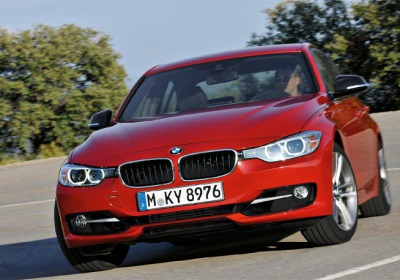BMW 3-series (2012): our comprehensive guide to F30
Thu, 17 Nov 2011
BMW has sold 12 million 3-series models since 1975; it’s an important car, one that accounts for a third of global BMW sales. The sixth-generation, codenamed F30, has a lot to live up to, then. Here are the key changes:
ChassisThe F30 is still, of course, rear-wheel drive, has 50:50 weight distribution, and sticks with the MacPherson strut front/multi-link rear suspension layout of its predecessors rather than following the double-wishbone front suspension employed by the new F10 5-series. The suspension is, however, much tweaked, and the chassis itself is all-new.
Four-wheel drive will be offered on right-hand drive cars for the first time (you could get a four-wheel drive E30 3-series back in the 1980s!), and, while the previous-generation M3 was the only 3-series to get a limited-slip differential, the new lesser Threes get an LSD-mimicking electronic diff – accelerate out of a hairpin and it will subtly brake the unloaded inside wheel to stop it spinning away power.
Ring the changesWe’ve already mentioned the optional four-wheel drive, but there’s more new stuff too: an eight-speed auto will be offered across the range; there’ll be a high-performance 335i hybrid; stop-start is standard; and there’s a Drive Performance Control to offer a choice of four driving modes, from Eco Pro to Sport+.
But perhaps the biggest shift is reserved for the 328i. Cast your mind back to the E36-generation of the 1990s and you might remember a 320i – most people would have guessed it was a four-cylinder, when in fact it was a silky smooth six. The new 328i pulls the opposite trick: that badging has previously been appended to six-cylinder BMWs, but now it’s a downsized turbocharged four. It makes 242bhp and 258lb ft, while delivering 44.1mpg and emitting 149g/km.
And while the last-generation 3-series mixed naturally aspirated and turbocharged petrols and diesels in its line-up, the F30 is the first ever 3-series to have nothing but turbo power. Yes, even the upcoming M3.
DimensionsThe all-new chassis incorporates a 50mm stretch in wheelbase to liberate more legroom. There’s also 8mm more headroom, plus 20 extra litres of stowage space in the boot. Overall length/width/height dimensions swell from the outgoing E90-generation’s 4531/1817/1421 to 4624/1811/1441mm. Despite this, a focus on weight-saving technology has shaved 50kg from the kerbweight.
Standard equipmentAs before, the 316d sits at the bottom of the 3-series ladder. Its price rises by £320 to £24,880, yet there’s much more standard kit than before: 17-inch alloys, automatic air-con, Bluetooth phone connectivity, BMW Professional radio with 6.5in colour screen and iDrive, keyless starting, a USB port, multi-function leather steering wheel, cruise control and automatic boot opening.
The 320dAh yes, the fleet favourite. In fact, if you want a diesel from the February 2012 launch date, only two are on offer, and both are badged 320d: the regular model and an eco-optimised EfficientDynamics variant. The regular model gets 181bhp, 280lb ft, 62.8mpg and 120g/km, while the 320d ED reduces power to 161bhp (torque remains the same), which partly helps to explain the improved 68.9mpg and 109g/km. Both 320d variants cost £28,080 – just £180 more than before – and you can expect the Efficient Dynamics to go down a storm on the company fleets – not only does it cost £20 to tax and brings low Benefit-In-Kind company car tax, but those firms that purchase a 320d ED outright will be able to write off 100 percent of its cost against tax.
The 316d and 318d will join the line-up next, while six-cylinder diesels will follow.
By Ben Barry

